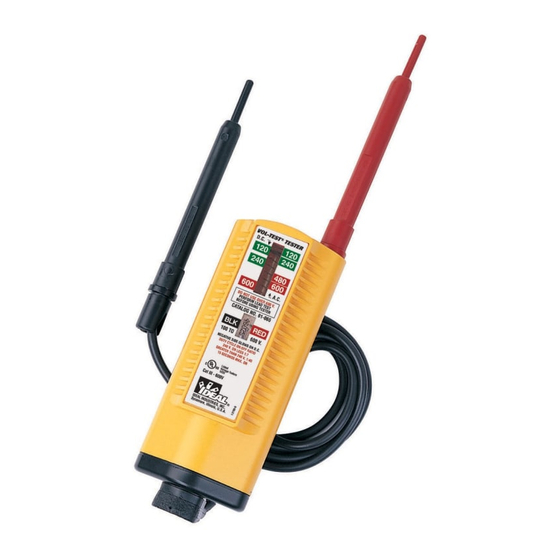
Ideal 61-065 Manual De Instrucciones
Ocultar thumbs
Ver también para 61-065:
- Manual del usuario (25 páginas) ,
- Manual de instrucciones (12 páginas)
Publicidad
Idiomas disponibles
Idiomas disponibles
ND 5119-5 61-065 Vol-Con Ins
#61-065
Voltage Tester
Instruction Manual
WARNING
Read First: Safety Information
Use the tester only as specified in this manual;
otherwise, the protection provided by the tester
may be impaired.
Warning
To avoid possible electric shock or personal
injury, follow these guidelines:
• Do not use tester if it is damaged. Visually
inspect tester to ensure case is not cracked.
• Inspect and replace leads if insulation is
damaged, metal is exposed, or probes are
cracked. Pay particular attention to the
insulation surrounding the connectors.
• Do not use tester if it operates abnormally as
protection maybe impaired.
• Do not use during electrical storms or in wet
weather.
• Do not use around explosive gas, dust, or vapor.
• Do not apply more than the rated voltage to
the tester. Voltage is not to exceed 600V.
• Always operate this solenoid-type tester
within the specified duty cycle on the front of
the tester. Duty cycle ratio is:
• 1:7 ON:OFF time for 240V or less
• 1:40 ON:OFF time for 240V or greater.
• Maximum ON time is 15 seconds.
Caution
To protect yourself, think "Safety First":
• Voltages exceeding 30VAC or 60VDC pose
a shock hazard so use caution.
• Never ground yourself when taking electrical
measurements.
2/19/07
9:18 AM
Page 1
• Use appropriate personal protective equipment
such as safety glasses, face shields, insulating
gloves, insulating boots, and/or insulating
mats.
• Use the 3-Step Testing Method. Before each
use:
• Verify tester operation by measuring a
known voltage. Apply tester to circuit under
test. And, then test on the known live volt-
age again to ensure proper operation.
• Connect the black common lead to ground
before applying the red test lead to voltage.
Disconnect the red test lead from the volt-
age first.
• Always work with a partner.
• When using the probes, keep fingers as far
behind the probe tips as possible.
Features:
• Vibration Mode with indicator movement
• Independent solenoid and electronic circuitry
design provides back-up voltage indication
for added safety
• Low Impedance Measuring Device
• Replaceable Test Leads
• Shielded probe tips
• Ultrasonically welded for added durability
Accessories:
• 61-072 Resistor-fused test leads
• C-90 Soft-sided carrying case
• 61-010 Leather case
To Measure AC Voltage:
• Ensure that the plug for the test leads is fully
seated into the banana jacks.
• Connect the tester in parallel with the load or
circuit.
• The tester indicates both the voltage type and
the voltage level.
To Measure DC Voltage:
• Ensure that the plug for the test leads is fully
seated into the banana jacks.
• Connect the tester in parallel with the load or
circuit.
• The tester indicates the voltage type, polarity,
and the voltage level.
2
Publicidad
Tabla de contenido

Resumen de contenidos para Ideal 61-065
- Página 1 ND 5119-5 61-065 Vol-Con Ins 2/19/07 9:18 AM Page 1 #61-065 • Use appropriate personal protective equipment such as safety glasses, face shields, insulating gloves, insulating boots, and/or insulating mats. • Use the 3-Step Testing Method. Before each Voltage Tester...
-
Página 2: Service, And Replacement Parts
Operating Environment: 32° F to 122° F Test Lead Replacement: (<70% humidity) • Replace leads only with IDEAL test leads Storage Temp.: -4° F to 140° F below. (<80% humidity) • # 61-070 Standard Test Leads with... -
Página 3: Warranty Statement
This tester is warranted to the original purchaser against defects in material and workmanship for five years after purchase. During this warranty period, IDEAL INDUSTRIES, INC. will, at it’ s Probador de voltaje test option, replace or repair the defective unit, sub- Manual de instrucciones ject to verification of the defect or malfunction. -
Página 4: Características
ND 5119-5 61-065 Vol-Con Ins 2/19/07 9:18 AM Page 7 Precaución Para medir el voltaje de CA: Para protegerse, piense en la "Seguridad ante • Asegúrese de que el enchufe de los cables todo": de prueba esté completamente asentado en •... -
Página 5: Mantenimiento
Piezas de servicio y repuesto: Cualquier garantía implícita que sea consecuen- Para obtener piezas de repuesto o preguntar sobre cia de la venta de un producto IDEAL se limita a contactos de información de servicio. lo de arriba, pero no se limita a garantías IDEAL INDUSTRIES, INC. - Página 6 ND 5119-5 61-065 Vol-Con Ins 2/19/07 9:18 AM Page 11 #61-065 • 1:7 délai ACTIF:INACTIF pour 240 V ou moins. • 1:40 délai ACTIF:INACTIF pour 240 V ou plus. • Le délai ACTIF maximum est de 15 sec- ondes. Testeur de tension Attention Mode d’emploi...
- Página 7 ND 5119-5 61-065 Vol-Con Ins 2/19/07 9:18 AM Page 13 • Dispositif de mesure à faible impédance • Test de fréquence de 25 à 60 Hz • Conducteurs d’essai remplaçables Placer un testeur entre les deux côtés d’une • Pointes de sondes protégées ligne c.a.
- Página 8 V c.a. valeur efficace. Toutes les garanties implicites résultant de la Environnement de fonctionnement : 0° à 50° C vente d'un produit IDEAL, y compris, mais non (32° F à 122° F) de façon limitative, les garanties de valeur (<...







